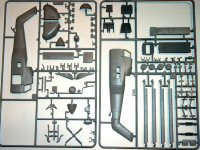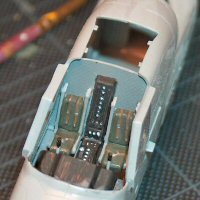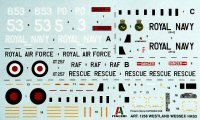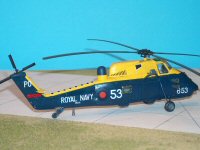|
MSRP: $17.50 USD
Those of you who read my Journal article on the Wessex know that this is an aircraft dear to my heart.
Derived from the unspectacular Sikorsky S-58, the Westland Wessex was the first truly useful anti-submarine helicopter, able as a single aircraft to both hunt and destroy the enemy submarine.
The HAS.3 version as featured in this kit was the ultimate ASW Wessex, fitted with the Rolls-Royce Gnome turbine engines and a new search radar in a distinctive dorsal hump.
 This kit is not new, being a re-issue of a 1990's kit, but it is a goodie nevertheless.
There are about 100 parts molded in light gray and clear plastic with a decal sheet featuring three options.
All is enclosed in a typical Italeri end-opening box.
Surface detail consists of finely engraved panel lines with raised detail as appropriate.
There are no prominent sink marks or ejector pin marks to be found.
The rotor blades are molded with a realistic droop, though they do feature rather heavy "panel lines" on them that should really be eliminated.
This kit is not new, being a re-issue of a 1990's kit, but it is a goodie nevertheless.
There are about 100 parts molded in light gray and clear plastic with a decal sheet featuring three options.
All is enclosed in a typical Italeri end-opening box.
Surface detail consists of finely engraved panel lines with raised detail as appropriate.
There are no prominent sink marks or ejector pin marks to be found.
The rotor blades are molded with a realistic droop, though they do feature rather heavy "panel lines" on them that should really be eliminated.
 Cockpit detail is pretty good, however Italeri have omitted the collective sticks; an unfortunate, though all too frequent occurrence with helicopter kits.
The main cabin is completely devoid of detail - this is the worst aspect of this kit as on the real HAS.3 there is a multitude of equipment down there and to leave it bare is a bit of a cop-out as far as I am concerned.
Cockpit detail is pretty good, however Italeri have omitted the collective sticks; an unfortunate, though all too frequent occurrence with helicopter kits.
The main cabin is completely devoid of detail - this is the worst aspect of this kit as on the real HAS.3 there is a multitude of equipment down there and to leave it bare is a bit of a cop-out as far as I am concerned.
Another area of concern here is the equipment bay ventilation grills that sit to the rear of the main rotor housing.
Through the grills one can see straight into the bare main cabin - definitely NOT prototypical.
I added a piece of 10 thou plastic card, painted black, to the underside of the grill piece to blank this off.
The main exhausts are too big, and when I do another one I shall replace them with lengths of brass tubing of the correct diameter and length.
Italeri correctly supply a nose intake shield for this mark, but beware that early Mk.3 aircraft did not sport these, and if you choose to leave it off, the detail of the intake is rather basic.
Converting the kit back to an HAS.1 is relatively easy - check your references.
Construction is pretty simple and posed no real problems.
The main rotor construction is straightforward, though I managed to break off one of the blades and had to pin it back on.
I had to use a little filler to blend in the fuselage underside piece 26, and don't forget to open the holes for parts 71 and 72 - it will make your life easier…
I would also recommend leaving off all the aerials until after painting and decaling, as these will get in your way and are not strongly attached.
Ask me how I know….
 As I mentioned, Italeri gives you three decal choices, though only one represents an operational machine.
Option 1 is fine except that the aircraft did not serve on HMS Antrim during the Falklands War - that honor went to the aircraft featured in option 3.
Incidentally, the name is the Falkland Islands or the Falklands, not "Falkland" as Italeri state.
Option 2 is not spurious as some have claimed; however, it does represent a grounded aircraft used for technical training at an RAF station and as such is not applicable to any front line service aircraft - RAF rescue Wessex were of the HAR.2 variant, a completely different machine.
I guess Italeri just wanted something different, but they could have stated that this is a one-off paint scheme, and non-operational to boot.
As I mentioned, Italeri gives you three decal choices, though only one represents an operational machine.
Option 1 is fine except that the aircraft did not serve on HMS Antrim during the Falklands War - that honor went to the aircraft featured in option 3.
Incidentally, the name is the Falkland Islands or the Falklands, not "Falkland" as Italeri state.
Option 2 is not spurious as some have claimed; however, it does represent a grounded aircraft used for technical training at an RAF station and as such is not applicable to any front line service aircraft - RAF rescue Wessex were of the HAR.2 variant, a completely different machine.
I guess Italeri just wanted something different, but they could have stated that this is a one-off paint scheme, and non-operational to boot.
Option 3 is correct if you wish to depict a museum display aircraft.
XP142, nicknamed Humphrey, was indeed HMS Antrim's operational Wessex during the Falklands War, but during that conflict it did not sport the ship's badge, or the red scoreboard on the main cabin door.
And in order to correctly depict her as a museum aircraft, you will need to add the battle damage she suffered and the red paint that highlighted it.
Better to leave off decals 2 and 6 for a true depiction of Humphrey during the war.
This is all rather disappointing, as given some basic research Italeri could have come up with a nice variety of schemes - check out Modeldecal sheet number 99 to see what I mean.
This seems to be a common thread with Italeri - there are any number of enthusiasts who can help them out here.
I have to say that this kit is a bit of a mixed bag.
Although the shape and dimensions are nice and the surface detail is generally good, the lack of main cabin detail and lack of attention to color schemes is disappointing.
The kit is an easy build though and makes a great basis for superdetailing; I would recommend picking up Modeldecal sheet 99 to complement your work.
In summary, I give this kit a "thumbs up," though with reservations.

My thanks to Italeri for supplying the review sample.
Italeri kits are available through all leading hobby outlets and online stores.
You can visit the Italeri website at: www.italeri.com.
|




